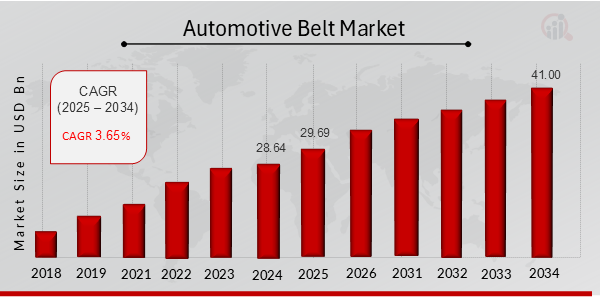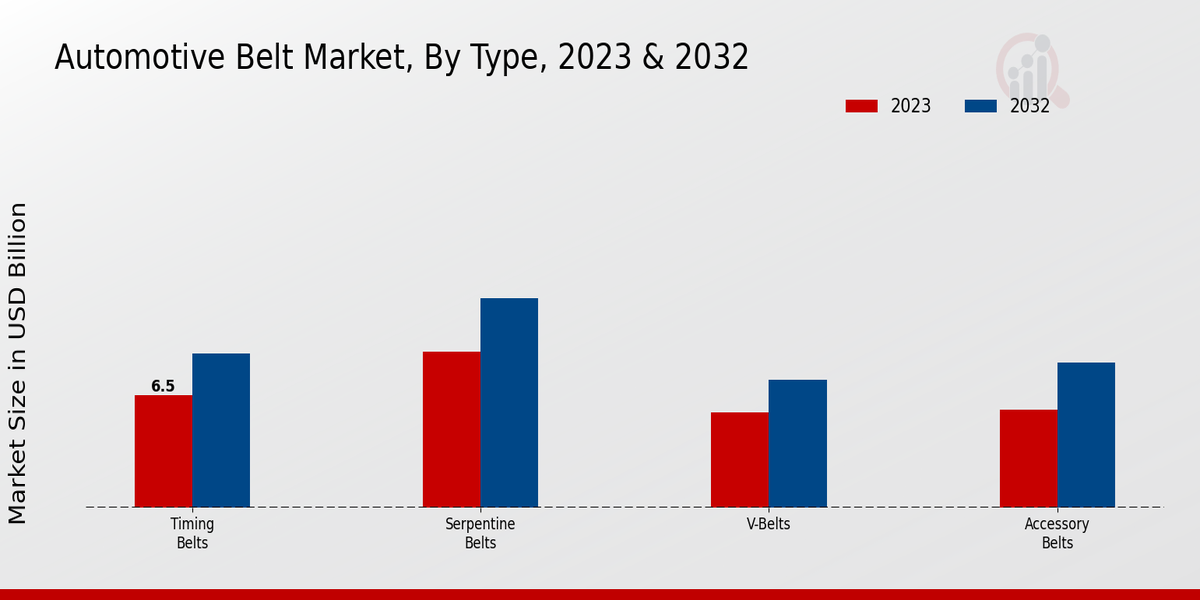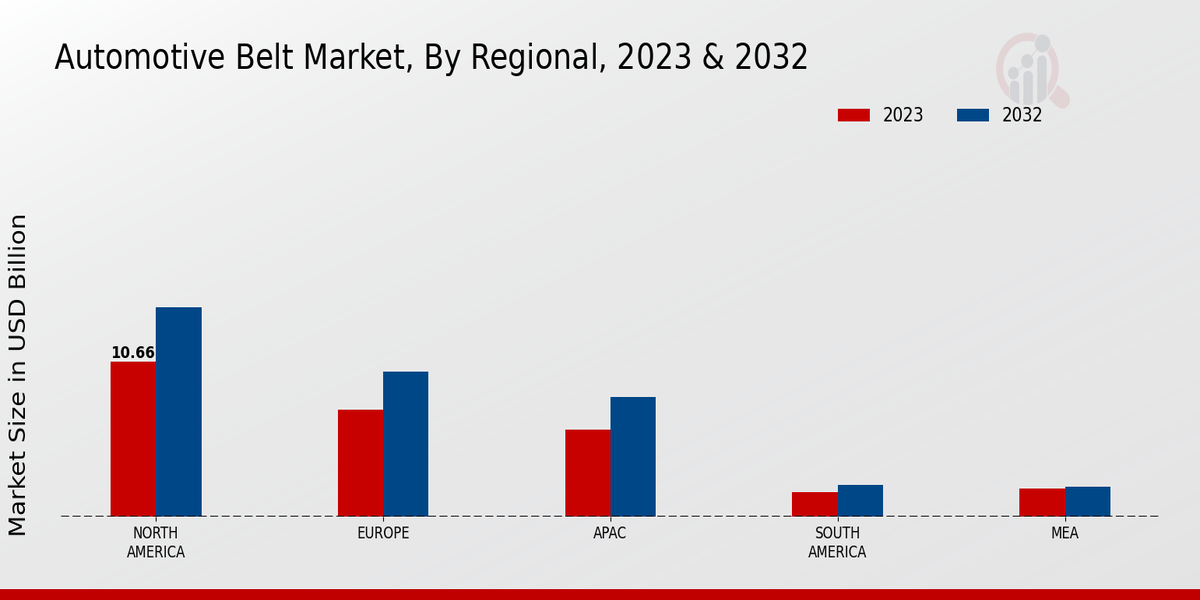Automotive Belt Market Overview
As per MRFR analysis, the Automotive Belt Market Size was estimated at 28.64 (USD Billion) in 2024. The Automotive Belt Market Industry is expected to grow from 29.69 (USD Billion) in 2025 to 41.00 (USD Billion) till 2034, at a CAGR (growth rate) is expected to be around 3.65% during the forecast period (2025 - 2034).
Key Automotive Belt Market Trends Highlighted
The Automotive Belt Market is influenced by several key market drivers. The growing automotive industry, fueled by increasing vehicle production, is a primary factor driving the demand for various types of belts, such as timing belts and accessory belts. The shift toward electric vehicles also plays a pivotal role, as it necessitates the development of new belt technologies to meet evolving performance standards.
Additionally, the rising awareness of vehicle maintenance and safety among consumers is pushing automotive manufacturers to focus on high-quality belt products that ensure reliable performance. There are numerous opportunities to be explored in this market.Innovations in materials and production techniques present avenues for creating more durable and efficient belts. The emphasis on lightweight components in vehicle manufacturing can lead to a higher demand for belts made from advanced materials that reduce overall vehicle weight without compromising on strength and longevity.
Furthermore, the expansion of after-market services provides a chance for companies to enhance their product range and cater to a broader customer base seeking replacement parts and upgrades. Recent trends indicate a growing inclination toward smart technologies integrated with automotive components. Intelligent belts with embedded sensors are emerging, offering real-time monitoring of performance and wear.This not only enhances the reliability of vehicles but also helps in predictive maintenance, ensuring that belts are replaced timely before any potential failure occurs.
Another noticeable trend is the increasing adoption of sustainable practices, with manufacturers exploring eco-friendly materials and production methods to align with global sustainability goals. This shift not only addresses environmental concerns but also meets consumer demand for greener automotive solutions. As these trends continue to evolve, stakeholders in the automotive belt market will need to adapt and innovate to stay competitive.

Source: Primary Research, Secondary Research, MRFR Database and Analyst Review
Automotive Belt Market Drivers
Growing Demand for Fuel-Efficient Vehicles
The Automotive Belt Market Industry is experiencing significant growth driven by the increasing demand for fuel-efficient vehicles. As environmental concerns continue to rise globally, more consumers are seeking vehicles that offer better fuel efficiency and lower carbon emissions. Automotive belts play a crucial role in the optimization of engine performance, ensuring that the vehicle operates smoothly while consuming less energy. The shift towards lightweight materials and advanced manufacturing techniques in the automotive sector is further enhancing the efficiency of belt systems.
Major automotive manufacturers are investing heavily in research and development to create innovative belt technologies that not only meet regulatory standards for emissions but also cater to consumer preferences for sustainable driving options. The growth of hybrid and electric vehicles also contributes to the increased need for specialized automotive belts that can withstand varying operating conditions associated with alternative powertrains.This shift in consumer behavior, alongside strict government regulations aimed at reducing vehicular emissions, is expected to propel the demand for advanced automotive belt systems in the market.
Technological Advancements in Automotive Belt Manufacturing
Technological advancements in automotive belt manufacturing are driving significant growth within the Automotive Belt Market Industry. Innovations in materials science have led to the development of stronger and more durable belts that enhance vehicle performance and longevity. This includes the use of synthetic materials that provide better resistance to wear and tear, temperature variations, and environmental factors. Additionally, automation and advanced tooling processes in manufacturing improve production efficiency and reduce costs.As manufacturers focus on improving product quality and consistency, these technological developments are expected to enhance the market's overall value proposition.
Rise in Global Automotive Production and Sales
The rise in global automotive production and sales is another key driver for the Automotive Belt Market Industry. With the increasing disposable income of consumers, particularly in emerging economies, there is a surge in demand for vehicles. This growth in the automotive sector directly correlates with the demand for automotive components, including belts. As manufacturers scale up production to meet consumer demand, the need for reliable and efficient automotive belts becomes paramount.This trend not only supports market growth but also encourages investment in new production techniques and materials to meet the evolving needs of the automotive industry.
Automotive Belt Market Segment Insights:
Automotive Belt Market Type Insights
The Automotive Belt Market has displayed a noteworthy valuation of 26.66 USD Billion in 2023, with projections to ascend to 36.8 USD Billion by 2032. This represents an anticipated shift reflecting a compound annual growth rate (CAGR) of 3.65 from 2024 to 2032. The segmentation of the market reveals distinct categories such as Timing Belts, Serpentine Belts, V-Belts, and Accessory Belts, each contributing uniquely to the overall revenue landscape. Timing Belts hold a significant position in the market, valued at 6.5 USD Billion in 2023 and projected to rise to 8.9 USD Billion in 2032, indicating their crucial role in engine timing and performance, which enhances their demand in the automotive sector.
Serpentine Belts, currently valued at 9.0 USD Billion, exhibit even greater dominance in the market, with a valuation expected to grow to 12.1 USD Billion by 2032. Their multi-functional capabilities, powering various accessories in vehicles, underlie their significant revenue contributions. The V-Belts segment, valued at 5.5 USD Billion in 2023, is projected to expand to 7.4 USD Billion in 2032, driven by their application in older vehicle models and machinery where space is limited. Meanwhile, Accessory Belts, which recorded a valuation of 5.66 USD Billion in 2023, are anticipated to grow to 8.4 USD Billion by 2032, serving essential functions in connecting various components such as alternators and water pumps, showing their relevance in daily vehicle operations.
Overall, the Automotive Belt Market segmentation not only highlights the importance of these components in automotive performance but also presents ample growth opportunities driven by technological advancements and increasing vehicle production rates. The diverse functionalities of these belts underpin their market growth, with Serpentine Belts and Timing Belts particularly commanding substantial shares and influencing global trends within the automotive industry. As vehicle manufacturers increasingly recognize the role of high-quality belts in enhancing vehicle efficiency, the market is poised for robust developments propelling its financial progress in the coming years.

Source: Primary Research, Secondary Research, MRFR Database and Analyst Review
Automotive Belt Market Material Insights
The Automotive Belt Market centered around the Material segment, is characterized by significant growth, with a market valuation expected to reach 26.66 USD Billion in 2023. This segment includes various materials, each contributing to the overall market dynamics. Rubber is widely recognized for its flexibility and durability, making it a preferred choice in many automotive applications. Polyester and Nylon are notable for their strength and resistance to various environmental factors, enhancing their relevance in the market. Additionally, Steel Reinforced materials are critical for applications requiring high tensile strength and reliability.The diverse characteristics of these materials drive innovation and product development, aligning with growing automotive industry demands.
The Automotive Belt Market data highlights the importance of these materials, showcasing how they cater to the intensifying need for efficiency and performance among manufacturers, emphasizing resilience and longevity as key attributes. The market growth is also propelled by trends towards more fuel-efficient vehicles, where these materials play a vital role in optimizing performance and durability.With the Automotive Belt Market segmentation revealing significant opportunities, the correct choice of materials remains essential for meeting various OEM specifications and consumer expectations.
Automotive Belt Market End Use Insights
The Automotive Belt Market, valued at 26.66 Billion USD in 2023, showcases a significant presence across various end-use categories, notably Passenger Cars, Commercial Vehicles, and Heavy-Duty Vehicles. The ever-growing automobile sector drives a substantial demand for automotive belts, primarily due to their critical role in ensuring optimal engine performance and vehicle efficiency. Passenger cars, which form a significant portion of the market, benefit from automotive belts that enhance fuel economy and prolong vehicle lifespan. Meanwhile, Commercial Vehicles are pivotal in logistics and transportation, leading to a high demand for robust and durable belts capable of withstanding rigorous use.
Heavy-Duty Vehicles, integral to construction and agriculture, rely on specialized automotive belts to support heavy loads and maintain operational stability. With the Automotive Belt Market expected to grow steadily, the segmentation reflects the broader trends of innovation and technology advancements, poised to meet the evolving demands of these diverse vehicle categories. The market data indicates a steady increase in the revenue streams attributable to these segments, highlighting growth opportunities driven by the ongoing electrification and automation of vehicles, as well as rising environmental regulations promoting fuel efficiency and lower emissions.
Automotive Belt Market Engine Type Insights
The Automotive Belt Market is a crucial segment of the automotive industry, reflecting the growing demand for efficient engine systems. In 2023, the market was valued at 26.66 billion USD, and it is poised for growth driven by various factors, including the rise in automotive production and increasing consumer preferences for fuel-efficient vehicles. Among the Engine Type categorization, the Internal Combustion Engine holds substantial significance due to its widespread usage in traditional vehicles, while the Hybrid Engine is gaining traction as consumers seek environmentally friendly options that combine internal combustion with electric power.
The Electric Engine segment is also becoming increasingly important as the global shift towards electrification and sustainability accelerates. Each of these engine types contributes distinctly to the overall Automotive Belt Market dynamics, driving innovations and enhancing market growth through operational efficiencies and reduced environmental impact, thus influencing Automotive Belt Market revenue and segmentation trends. Current market statistics showcase notable interest in these engine types, presenting various opportunities for manufacturers and stakeholders in the global market landscape.
Automotive Belt Market Regional Insights
The Automotive Belt Market exhibits a robust valuation across various regions, showcasing the diverse dynamics of the industry. In 2023, North America holds a majority holding with a market value of 10.66 USD Billion, reflecting its significant automotive industry and technological advancements, while it is projected to reach 14.36 USD Billion by 2032. Europe follows closely at 7.36 USD Billion in 2023, driven by stringent regulations promoting vehicle safety and performance, and is expected to rise to 9.94 USD Billion.
The Asia-Pacific (APAC) region, valued at 6.0 USD Billion, benefits from a robust automotive production base and consumer demand, with a forecast growth of 8.2 USD Billion.South America and Middle East Africa (MEA) represent smaller but important segments, valued at 1.7 USD Billion and 1.94 USD Billion in 2023, respectively, highlighting emerging opportunities amidst economic growth and expanding automotive markets. The Automotive Belt Market revenue growth is influenced by rising vehicle production, innovation in automotive technology, and increasing consumer awareness regarding safety, creating opportunities while facing challenges from geopolitical shifts and supply chain disruptions.

Source: Primary Research, Secondary Research, MRFR Database and Analyst Review
Automotive Belt Market Key Players and Competitive Insights:
The Automotive Belt Market is characterized by a diverse array of players and an increasing emphasis on technological advancements and innovations. This market is essential for various automotive applications, including power transmission and timing operations within vehicles. Competitive dynamics within this segment are influenced by factors such as increasing vehicle production, rising demand for fuel-efficient systems, and expanding electric vehicle adoption. Companies in this market strive to enhance their product offerings while focusing on strategic collaborations and partnerships to gain a competitive edge. The rising concern over environmental sustainability has also propelled manufacturers to adopt eco-friendly materials in their belt production, shaping the market landscape.
Bando has carved a substantial presence in the Automotive Belt Market, beloved for its innovative approaches and superior product quality. The company’s strengths lie in its extensive research and development capabilities, allowing it to continually refine its offerings to meet the evolving needs of the automotive sector. Bando’s commitment to technological advancements is reflected in its efficient manufacturing processes and a strong focus on sustainability, positioning it favorably among competitors. Additionally, its robust distribution network ensures that Bando’s products are readily available in various key markets, reinforcing its established brand credibility. Their ability to adapt to changing consumer requirements while maintaining high-performance standards helps in garnering a loyal customer base, thus solidifying their position in a competitive landscape.
Tsubaki stands out in the Automotive Belt Market, driven by its dedication to quality, efficiency, and innovation. The company's strength is founded on its comprehensive expertise in manufacturing high-performance belts suitable for diverse automotive applications. Tsubaki's extensive product range showcases its adaptability in meeting market demands, providing tailored solutions that cater to specific automotive needs. Furthermore, the company invests significantly in state-of-the-art technology and operates with a robust manufacturing framework that emphasizes precision and reliability. Tsubaki’s global presence and strategic alliances enhance its distribution capabilities, enabling it to serve customers across various regions effectively. The combination of advanced engineering and customer-oriented services strengthens Tsubaki’s competitive position, allowing it to thrive in the dynamic and ever-evolving automotive belt market.
Key Companies in the Automotive Belt Market Include:
- Bando
- Tsubaki
- Optibelt
- Carlisle
- Maval Industries
- Schaeffler
- Dayco
- Mitsubishi
- Continental
- Hutchinson
- Fenner
- Mitsubishi
- Gates
- KMC
- Goodyear
Automotive Belt Market Industry Developments
In recent developments within the Automotive Belt Market, companies like Bando, Tsubaki, and Gates have been focusing on innovations to meet evolving consumer demands, particularly for sustainable and high-performance products. The automotive industry is witnessing a heightened emphasis on electric vehicles, which has led firms like Schaeffler and Dayco to expand their product lines to cater to new market requirements. Furthermore, the market has seen significant growth, attributed largely to increased production and consumption in emerging economies, consequently boosting the valuations of many players, including Continental and Goodyear.
Recent reports also highlighted mergers and acquisitions among notable companies, including a strategic partnership between KMC and a leading manufacturer aimed at enhancing market share and operational efficiency. Optibelt has engaged in discussions regarding potential collaboration with Maval Industries to foster shared technology advancements. These movements in the automotive belt sector leverage synergies to bolster competitive edge and increase consumer outreach in a rapidly changing landscape. The ongoing dynamics within the market suggest a period of consolidation, innovation, and growth, reflecting the industry's adaptability in response to changing automotive trends.
Automotive Belt Market Segmentation Insights
Automotive Belt Market Type Outlook
- Timing Belts
- Serpentine Belts
- V-Belts
- Accessory Belts
Automotive Belt Market Material Outlook
- Rubber
- Polyester
- Nylon
- Steel Reinforced
Automotive Belt Market End Use Outlook
- Passenger Cars
- Commercial Vehicles
- Heavy-Duty Vehicles
Automotive Belt Market Engine Type Outlook
- Internal Combustion Engine
- Hybrid Engine
- Electric Engine
Automotive Belt Market Regional Outlook
- North America
- Europe
- South America
- Asia Pacific
- Middle East and Africa
| Report Attribute/Metric |
Details |
|
Market Size 2024
|
28.64 (USD Billion)
|
|
Market Size 2025
|
29.69 (USD Billion)
|
|
Market Size 2034
|
41.00 (USD Billion)
|
|
Compound Annual Growth Rate (CAGR)
|
3.65% (2025 - 2034)
|
|
Report Coverage
|
Revenue Forecast, Competitive Landscape, Growth Factors, and Trends
|
|
Base Year
|
2024
|
|
Market Forecast Period
|
2025 - 2034
|
|
Historical Data
|
2019 - 2023
|
| Market Forecast Units |
USD Billion |
| Key Companies Profiled |
Bando, Tsubaki, Optibelt, Carlisle, Maval Industries, Schaeffler, Dayco, Mitsubishi, Continental, Hutchinson, Fenner, Mitsubishi, Gates, KMC, Goodyear |
| Segments Covered |
Type, Material, End Use, Engine Type, Regional |
| Key Market Opportunities |
Electric vehicle integration, Increased demand for lightweight materials, Growth in aftermarket sales, Advanced manufacturing technologies, Sustainability and eco-friendly products |
| Key Market Dynamics |
Increasing vehicle production, Growing demand for fuel efficiency, Technological advancements in materials, Rising electric vehicle adoption, Stringent government regulations |
| Countries Covered |
North America, Europe, APAC, South America, MEA |
Frequently Asked Questions (FAQ) :
The Automotive Belt Market is expected to be valued at 41.00 USD Billion in 2034.
The expected CAGR for the Automotive Belt Market from 2025 to 2034 is 3.65%.
North America is expected to hold the largest market share with a projected value of 14.36 USD Billion in 2032.
The market value of Serpentine Belts is projected to reach 12.1 USD Billion in 2032.
Key players in the Automotive Belt Market include Bando, Tsubaki, Optibelt, Gates, and Goodyear.
The expected market size for Timing Belts in 2023 is 6.5 USD Billion.
The V-Belts market is expected to grow to 7.4 USD Billion by 2032.
The projected market value of the Automotive Belt Market in Europe for 2032 is 9.94 USD Billion.
The estimated market size of Accessory Belts in 2032 is forecasted to be 8.4 USD Billion.
The main growth drivers for the Automotive Belt Market include increasing vehicle production and advancements in automotive technologies.

















